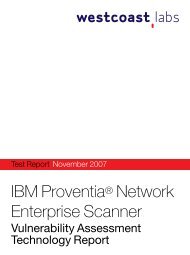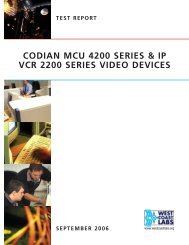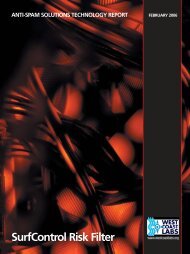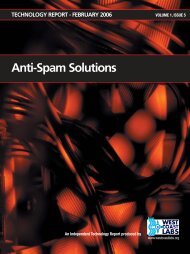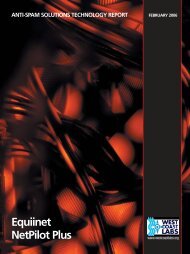Panda GateDefender Performa 8100 - West Coast Labs
Panda GateDefender Performa 8100 - West Coast Labs
Panda GateDefender Performa 8100 - West Coast Labs
Create successful ePaper yourself
Turn your PDF publications into a flip-book with our unique Google optimized e-Paper software.
<strong>Panda</strong> <strong>GateDefender</strong> <strong>Performa</strong> <strong>8100</strong><br />
In a recent interview, Dr Richard Cullen, distinguished engineer at<br />
SurfControl said, “The threat landscape has changed dramatically over<br />
the past couple of years. Malware attacks are now commercial ventures,<br />
with well organized cybercrime gangs harnessing the power of vast botnet<br />
armies to launch spam, phishing, DDOS and malware attacks.”<br />
The spammers are also always trying to find new ways of bypassing antispam<br />
defenses. One such technique that is on the increase is image spam<br />
– emails with images containing the spammer’s messages within random<br />
text designed to foil less sophisticated spam filters. Peter Firstbrook, security<br />
research director for Gartner, has reported that image spam went from 6<br />
percent of all spam in Q3 of 2006 to 30 percent by Q4, and it is now thought<br />
to make up almost 40% of all spam.<br />
Apart from being harder to block, image spam also causes knock-on<br />
problems because the spam messages are actually larger than simple<br />
text messages. According to some reports, the average size of a spam<br />
message has increased by 77% since September last year, from 6.62Kbytes<br />
to 11.76K) and continues steadily to grow. This adds to the cost of managing<br />
email, it wastes bandwidth and also consumes storage if a company needs<br />
to archive all incoming mail.<br />
And according to the New York Times security columnist John Markoff, one<br />
recent botnet outbreak managed to consume 15% of Yahoo’s resources<br />
while searching for random pieces of text to pad out such image-based<br />
messages.<br />
As a result, anti-spam vendors are now having to adapt to this new threat<br />
by both enhancing existing techniques such as heuristics rules to analyze<br />
the characteristics of image-based spam, and by adding new technology<br />
layers, such as optical character recognition technologies. Where will it all<br />
end?<br />
www.westcoastlabs.com Test Report 5



